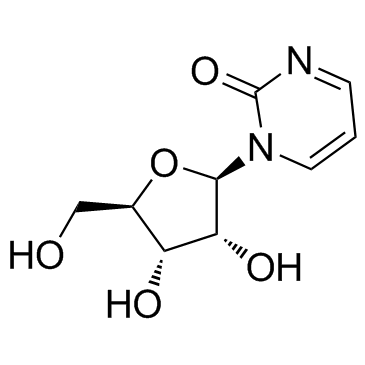Zebularine

Zebularine structure
|
Common Name | Zebularine | ||
|---|---|---|---|---|
| CAS Number | 3690-10-6 | Molecular Weight | 228.202 | |
| Density | 1.7±0.1 g/cm3 | Boiling Point | 499.0±55.0 °C at 760 mmHg | |
| Molecular Formula | C9H12N2O5 | Melting Point | 160-162?C | |
| MSDS | Chinese USA | Flash Point | 255.6±31.5 °C | |
|
The potential of clofarabine in MLL-rearranged infant acute lymphoblastic leukaemia.
Eur. J. Cancer 51 , 2008-21, (2015) MLL-rearranged acute lymphoblastic leukaemia (ALL) in infants is the most difficult-to-treat type of childhood ALL, displaying a chemotherapy-resistant phenotype, and unique histone modifications, gene expression signatures and DNA methylation patterns. MLL-r... |
|
|
DNA Methylation Inhibitor Zebularine Confers Stroke Protection in Ischemic Rats.
Transl. Stroke Res. 6 , 296-300, (2015) 5-Aza-deoxycytidine (5-aza-dC) confers neuroprotection in ischemic mice by inhibiting DNA methylation. Zebularine is another DNA methylation inhibitor, less toxic and more stable in aqueous solutions and, therefore more biologically suitable. We investigated ... |
|
|
Light signaling controls nuclear architecture reorganization during seedling establishment.
Proc. Natl. Acad. Sci. U. S. A. 112 , E2836-44, (2015) The spatial organization of chromatin can be subject to extensive remodeling in plant somatic cells in response to developmental and environmental signals. However, the mechanisms controlling these dynamic changes and their functional impact on nuclear activi... |
|
|
Dnmts and Tet target memory-associated genes after appetitive olfactory training in honey bees.
Sci. Rep. 5 , 16223, (2015) DNA methylation and demethylation are epigenetic mechanisms involved in memory formation. In honey bees DNA methyltransferase (Dnmt) function is necessary for long-term memory to be stimulus specific (i.e. to reduce generalization). So far, however, it remain... |
|
|
Aberrant Retinoblastoma (RB)-E2F Transcriptional Regulation Defines Molecular Phenotypes of Osteosarcoma.
J. Biol. Chem. 290 , 28070-83, (2015) We previously identified two distinct molecular subtypes of osteosarcoma through gene expression profiling. These subtypes are associated with distinct tumor behavior and clinical outcomes. Here, we describe mechanisms that give rise to these molecular subtyp... |
|
|
Pyrimidinone: versatile Trojan horse in DNA photodamage?
Photochem. Photobiol. Sci. 14 , 1598-606, (2015) (6-4) Photolesions between adjacent pyrimidine DNA bases are prone to secondary photochemistry. It has been shown that singlet excited (6-4) moieties form Dewar valence isomers as well as triplet excitations. We here report on the triplet state of a minimal m... |
|
|
IMP-GMP specific cytosolic 5'-nucleotidase regulates nucleotide pool and prodrug metabolism.
Biochim. Biophys. Acta 1850 , 1354-61, (2015) Type II cytosolic 5'-nucleotidase (cN-II) catalyzes the hydrolysis of purine and, to some extent, of pyrimidine monophosphates. Recently, a number of papers demonstrated the involvement of cN-II in the mechanisms of resistance to antitumor drugs such as cytar... |
|
|
Epidrug mediated re-expression of miRNA targeting the HMGA transcripts in pituitary cells.
Pituitary 18 , 674-84, (2015) Transgenic mice overexpressing the high mobility group A (HMGA) genes, Hmga1 or Hmga2 develop pituitary tumours and their overexpression is also a frequent finding in human pituitary adenomas. In some cases, increased expression of HMGA2 but not that of HMGA1... |
|
|
An epigenetic screen unmasks metallothioneins as putative contributors to renal cell carcinogenesis.
Urol. Int. 94(1) , 99-110, (2015) Functional epigenetic studies aimed to re-express transcriptionally silenced genes in renal cell carcinoma (RCC) may facilitate the ongoing search for appropriate markers supporting clinical decision-making.The RCC cell line A-498 was treated with the DNA met... |
|
|
Noradrenaline goes nuclear: epigenetic modifications during long-lasting synaptic potentiation triggered by activation of β-adrenergic receptors.
J. Physiol. 594 , 863-81, (2016) Transcription is recruited by noradrenaline in the hippocampus. Epigenetic mechanisms are recruited by hippocampal noradrenergic receptor activation. Epigenetic regulation by noradrenaline offers a novel mechanism for long-term potentiationNoradrenaline (NA) ... |